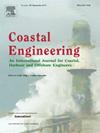Equilibrium shoreline change model with non-stationary free parameters at Hasaki Beach, Japan
IF 4.5
2区 工程技术
Q1 ENGINEERING, CIVIL
引用次数: 0
Abstract
The ability to accurately predict shoreline response to changing wave conditions is crucial for coastal management, with equilibrium-based shoreline models demonstrating success in forecasting shoreline evolution across various temporal scales. However, the conventional use of time-invariant parameters in these models may limit their capability to capture the full range of beach responses, particularly during extreme events. This study investigates the non-stationary characteristics of free parameters in the equilibrium shoreline model ShoreFor and evaluates alternative wave-forcing variants to enhance model performance. Using a unique, high-frequency dataset of shoreline positions collected at daily to weekly intervals with low measurement uncertainty from 1991 to 2015 at Hasaki Beach, Japan, we implement both stationary and non-stationary parameter approaches. We develop a novel segmentation method where the 20-year calibration period (1991-2010) is divided into monthly segments to capture wave seasonal patterns, with model performance evaluated over a 10-year interval within calibration and a 5-year validation period. Comparative analysis of three wave-forcing variants—significant wave height (), dimensionless settling velocity (), and wave energy ()—reveals that provides more stable and superior performance at Hasaki Beach compared to the alternatives. Analysis of segment-derived relationships shows highly variable accretion efficiency coefficients () with a weak positive correlation between significant wave height and accretion efficiency, potentially indicating more efficient shoreline restoration during higher wave periods. Notably, these segment-derived parameter relationships maintain their validity when applied to longer continuous simulations, despite being calibrated within discrete temporal windows. The non-stationary model with as forcing variant substantially improves model performance during calibration, increasing the correlation coefficient from 0.36 to 0.61, and better captures extreme erosion and accretion events throughout both calibration and validation periods. These findings demonstrate the importance of incorporating time-varying parameters in equilibrium-based models and guide the selection of appropriate wave-forcing variants for improving future shoreline change predictions under changing wave climate.
日本Hasaki海滩非平稳自由参数的平衡海岸线变化模型
准确预测海岸线对变化的波浪条件的反应的能力对海岸管理至关重要,基于平衡的海岸线模型在预测不同时间尺度的海岸线演变方面取得了成功。然而,在这些模型中常规使用时不变参数可能会限制它们捕捉海滩响应的全部范围的能力,特别是在极端事件期间。本文研究了平衡海岸线模型ShoreFor中自由参数的非平稳特征,并评估了波浪强迫的替代变量,以提高模型的性能。利用1991年至2015年在日本Hasaki海滩收集的海岸线位置的独特高频数据集,以低测量不确定度为间隔,我们实施了平稳和非平稳参数方法。我们开发了一种新的分割方法,将20年的校准期(1991-2010)划分为每月的片段来捕捉波浪的季节模式,并在校准期间以10年的间隔和5年的验证期评估模型的性能。三种波浪强迫变量——有效波高(Hs)、无因次沉降速度(Ω)和波能(P)——的对比分析表明,Hs在Hasaki海滩提供了更稳定和优越的性能。分段关系分析显示,显著波高与增积效率之间呈弱正相关,增积效率系数(Ca)变化很大,这可能表明在高波期时海岸线恢复效率更高。值得注意的是,尽管在离散时间窗口内进行校准,但这些分段衍生的参数关系在应用于较长时间的连续模拟时仍保持其有效性。以Hs为强迫变量的非平稳模型在校准期间显著提高了模型性能,将相关系数从0.36提高到0.61,并在校准和验证期间更好地捕获极端侵蚀和吸加事件。这些发现证明了在基于平衡的模型中加入时变参数的重要性,并指导选择适当的波浪强迫变量,以改善波浪气候变化下的未来海岸线变化预测。
本文章由计算机程序翻译,如有差异,请以英文原文为准。
求助全文
约1分钟内获得全文
求助全文
来源期刊

Coastal Engineering
工程技术-工程:大洋
CiteScore
9.20
自引率
13.60%
发文量
0
审稿时长
3.5 months
期刊介绍:
Coastal Engineering is an international medium for coastal engineers and scientists. Combining practical applications with modern technological and scientific approaches, such as mathematical and numerical modelling, laboratory and field observations and experiments, it publishes fundamental studies as well as case studies on the following aspects of coastal, harbour and offshore engineering: waves, currents and sediment transport; coastal, estuarine and offshore morphology; technical and functional design of coastal and harbour structures; morphological and environmental impact of coastal, harbour and offshore structures.
 求助内容:
求助内容: 应助结果提醒方式:
应助结果提醒方式:


